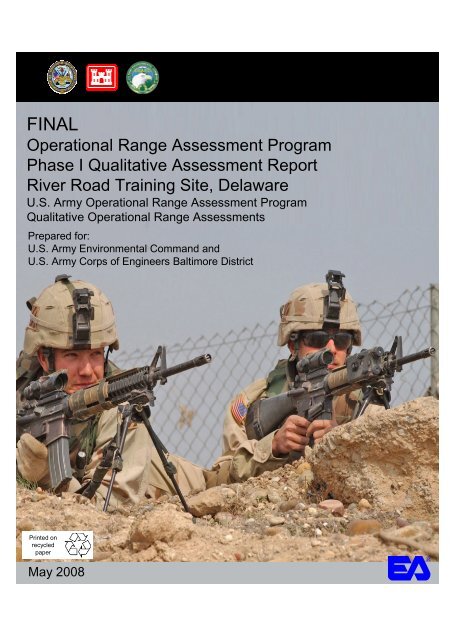Operational Range Assessment Program Phase I Qualitative ...
Operational Range Assessment Program Phase I Qualitative ...
Operational Range Assessment Program Phase I Qualitative ...
- No tags were found...
You also want an ePaper? Increase the reach of your titles
YUMPU automatically turns print PDFs into web optimized ePapers that Google loves.
FINAL<strong>Operational</strong> <strong>Range</strong> <strong>Assessment</strong> <strong>Program</strong><strong>Phase</strong> I <strong>Qualitative</strong> <strong>Assessment</strong> ReportRiver Road Training Site, DelawareU.S. Army <strong>Operational</strong> <strong>Range</strong> <strong>Assessment</strong> <strong>Program</strong><strong>Qualitative</strong> <strong>Operational</strong> <strong>Range</strong> <strong>Assessment</strong>sPrepared for:U.S. Army Environmental Command andU.S. Army Corps of Engineers Baltimore DistrictPrinted onrecycledpaperMay 2008®
<strong>Operational</strong> <strong>Range</strong> <strong>Assessment</strong> <strong>Program</strong>, <strong>Phase</strong> I <strong>Qualitative</strong> <strong>Assessment</strong> Report May 2008River Road Training Site, DelawareABBREVIATIONS/ACRONYMSARID-GEO Army <strong>Range</strong> Inventory Database-GeodatabaseCERCLA Comprehensive Environmental Response, Compensation, and Liability ActCSMConceptual Site ModelDoDDepartment of DefenseDODIDepartment of Defense InstructionEEcological receptors identified. (This refers to range grouping; pathwaydesignation always precedes E designation.)GWGroundwater pathway identified. (This refers to range grouping; Mdesignation always precedes GW designation.)HHuman receptors identified. (This refers to range grouping; pathwaydesignation always precedes H designation.)LSLimited SourceMMunitions used. (This refers to range grouping; M designation alwaysprecedes applicable pathway.)MCOCMunitions Constituents of ConcernNGNitroglycerinNGBNational Guard BureauNRCSNatural Resources Conservation ServiceORAP<strong>Operational</strong> <strong>Range</strong> <strong>Assessment</strong> <strong>Program</strong>PUPathway unlikely or incomplete. (This refers to range grouping; Mdesignation always precedes PU designation.)RFMSS<strong>Range</strong> Facility Management Support SystemSWSurface water pathway identified. (This refers to range grouping; Mdesignation always precedes SW designation.)TSTraining SiteU.S.United StatesUSACEUnited States Army Corps of EngineersUSACHPPM United States Army Center for Health Promotion and Preventive MedicineUSAECUnited States Army Environmental CommandUSDAUnited States Department of AgricultureUSEPAUnited States Environmental Protection Agency°F Degrees FahrenheitEA Engineering, Science, and Technology, Inc.iv
<strong>Operational</strong> <strong>Range</strong> <strong>Assessment</strong> <strong>Program</strong>, <strong>Phase</strong> I <strong>Qualitative</strong> <strong>Assessment</strong> Report May 2008River Road Training Site, DelawareEXECUTIVE SUMMARYThe United States (U.S.) Army is conducting qualitative assessments at operational ranges to meet therequirements of Department of Defense policy and to support the U.S. Army Sustainable <strong>Range</strong><strong>Program</strong>. The operational range qualitative assessment (hereinafter referred to as <strong>Phase</strong> I<strong>Assessment</strong>) is the first phase of the U.S. Army <strong>Operational</strong> <strong>Range</strong> <strong>Assessment</strong> <strong>Program</strong> (ORAP).This <strong>Phase</strong> I <strong>Assessment</strong> evaluates the operational range area at River Road Training Site (TS) toassess whether further investigation is needed to determine if potential munitions constituents ofconcern (MCOC) are or could be migrating off-range at levels that may pose an unacceptable risk tohuman health or the environment. In conducting the <strong>Phase</strong> I <strong>Assessment</strong>, MCOC sources, potentialoff-range migration pathways, and potential off-range human and ecological receptors are evaluatedas appropriate.River Road TS, formerly known as New Castle Rifle <strong>Range</strong>, is a 199-acre installation located in thecity of New Castle, New Castle County, Delaware and is situated approximately 10 miles south ofWilmington. The 13 operational ranges at River Road TS include four small arms ranges, sixmaneuver/training areas, and three helipads, totaling 181.60 acres. The remaining 17.4 acres consistof non-operational areas. Small caliber munitions are currently, and were historically used at RiverRoad TS. In addition, range activities may have included the use of Korean War-era large caliberpractice munitions. Potential surface water and groundwater pathways exist and there are potentialecological receptors located down gradient; however, these receptors are unlikely to be affected dueto the volume of water flowing in the Delaware River.The 13 operational ranges at River Road TS are categorized as Unlikely.Unlikely – Five-Year ReviewThe 13 operational ranges at River Road TS are categorized as Unlikely, totaling 181.60 acres. Theseranges consist of four small arms ranges, six maneuver/training areas, and three helipads. <strong>Range</strong>swhere, based upon a review of readily available information, there is sufficient evidence to show thatthere are no known releases or source-receptor interactions off-range that could present anunacceptable risk to human health or the environment are categorized as Unlikely. <strong>Range</strong>scategorized as Unlikely are required to be re-evaluated at least every five years. Re-evaluation mayoccur sooner if significant changes (e.g., change in range operations or site conditions, regulatorychanges) occur that affect determinations made during this <strong>Phase</strong> I <strong>Assessment</strong>.Table ES-1 summarizes the <strong>Phase</strong> I <strong>Assessment</strong> findings.EA Engineering, Science, and Technology, Inc.ES-1
<strong>Operational</strong> <strong>Range</strong> <strong>Assessment</strong> <strong>Program</strong>, <strong>Phase</strong> I <strong>Qualitative</strong> <strong>Assessment</strong> Report May 2008River Road Training Site, DelawareTable ES-1: Summary of Findings and Conclusions for River Road Training SiteCategoryUnlikelyTotal Numberof <strong>Range</strong>s andAcreage Source(s) Pathway(s)13 operationalranges;181.60 acresSmall arms range firing lines,impact berms, and historicalimpact areasNo source – limited or nomilitary munitions useSurface water andgroundwaterHumanReceptorsNoneEcologicalReceptorsSensitive speciesand environmentspresent in areasadjacent to theinstallationNot evaluated (no source was identified)Conclusions and RationaleRe-evaluate during the five-yearreview. The receptors identifiedare unlikely to be affected bypotential MCOC due to the sizeand flow rate of the DelawareRiver.Re-evaluate during the five-yearreview. No source wasidentified.EA Engineering, Science, and Technology, Inc. ES-2
















